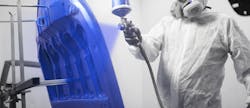Axalta offers tips on spraying paint in cold weather
Editor's note: This article was originally published in 2011 and has been updated to reflect the name change from DuPont to Axalta.
Content brought to you by Auto Body Repair Network. To subscribe, click here.
Athletes warm up a little more before competition on colder days. Motorists know that engine oil becomes thicker in the winter cold. Things are not all that different with clearcoats and hardeners, which also tend to become more viscous during the cold season if not stored properly.
Paint material should have a temperature of 68°F (20°C) to 77°F (25°C) for spraying, as this ensures the best reaction between the clearcoat and the hardener. For chemical reactions to run smoothly, warm conditions are much better than cold. This is the reason why you heat up a low bake oven for drying clearcoat. It is virtually impossible to achieve perfect surface results with cold paint materials, because it will inevitably produce flaws.
The same applies to the substrates. Care should be taken that the vehicle body is not too cold before applying the paint. If the substrate is too cold, this will have an adverse impact on the flow and the surface finish.
To ensure consistent quality, the labs at Standox test everything under standardized conditions. The same is true of our production department, which delivers our clearcoats with a defined viscosity. Standox knows that body shops cannot always guarantee the same perfect conditions as our labs. While Standox products are relatively adaptable, certain minimum conditions must be ensured to avoid flaws. Processing and storage temperature of 68°F (20°C) is ideal.
If the product appears to be too viscous, although you have mixed it correctly; you should check the temperature of the material. In many cases, it is too cold. Adding thinner in order to reduce the viscosity is not the right solution. This is not only bad for the environment and your wallet but will also cause flaws such as orange peel. Adding more coats to achieve a smooth flow will do even more harm, as excessive coats may lead to blisters and sagging.For more information, visit www.axalta.com.
